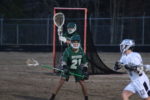Starting in January of 2006, Christine Mayfield taught English at a high school in New Orleans, where students were recovering from the effects of Hurricane Katrina.
“Many [students] were not in good shape academically, and lots were returning on their own, sleeping where they could, on couches of relatives, and finding jobs of some kind to get by,” said Mayfield, who retired from Northwood last year.
“It was difficult to find a balance between upholding academic standards and dealing with the severe challenges that these students faced,” Mayfield said.
Mayfield remembers that students were returning to school at their own pace, which inhibited her ability to teach effectively.
“I felt I had to be flexible about deadlines, for example, as attendance was spotty,” Mayfield said.
As she continued to teach, she began to realize that her job as a teacher had differed from what she had been expecting.
“I felt that my job was to follow the students’ needs and aspirations as strongly as I could, rather than going in with a preconceived set idea of what they should be doing,” Mayfield said. “I still feel that this is the basic mission of teachers.”
While students at Northwood may not deal with outside factors as extreme as Hurricane Katrina, teachers still may have differing expectations for students who face hardships outside of the classroom.
“I like to be aware that there is something going on [outside of the classroom],” said Cari Christopherson, who teaches biology and AVID. “For some kids, school is not the main focus. Sleeping and getting food is.”
Christopherson said she tends to be somewhat lenient with her students when it comes to deadlines and expectations.
“If I know what is going on, like if a student is really tired or hungry, they can talk to me about it and get an extension,” Christopherson said.
In the classroom, Christopherson tries to connect with each of her students individually in order to teach them to the best of her ability.
“I know that for 75 percent of my students, school is not a priority, so I try to use my time with them wisely,” Christopherson said. “I try to teach life lessons indirectly, but I also try to get the content in there in some way, shape or form.”
Terrence Foushee teaches both AVID and English classes.
“I believe that all students can learn and that all students have potential that they can unlock,” Foushee said. “But, I do understand that not every student is the same.”
Like Christopherson, Foushee tries to accommodate each student individually based on their needs in the classroom.
“I try to keep the lines of communication open, allowing [my students] to talk to me whenever they need to,” Foushee said. “I also give extensions so that they have time to complete their work.”
Access to resources at home such as the internet proves to be a limiting factor in terms of students’ ability to complete assignments.
“There are a lot of challenges that come with having students without access to the same resources as others,” Foushee said.
Similar to his colleagues, and exceptional children’s (EC) teacher David Holub believes that there is difficulty when it comes to teaching students who have a bigger focus on the things happening in their lives outside of the classroom.
“[The EC Staff has] a lot of different students with a lot of different needs that could be economic, physical or emotional,” Holub said. “We have to take all of those things into account.”
Alex Hart attended Northwood as a high school student and now is the AVID Coordinator and a physical education teacher. He shares some of the same beliefs regarding a student’s ability to learn in different situations.
“It’s really important as a teacher to understand the demographics of the students that you teach, because the way that kids are raised and their cultures are so important to who they are as a person,” Hart said.
Hart believes that there’s a way to teach students the same way regardless of their background.
“When an opportunity gap exists between students, I think it becomes imperative for the teacher to identify what those are and figure out what resources they can bring as a teacher to assist them,” Hart said. “I think the best thing we can give students is our time.”
– By Rachel Stoner

